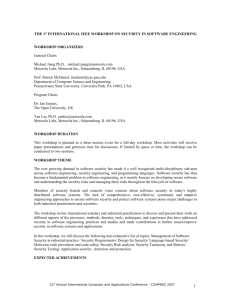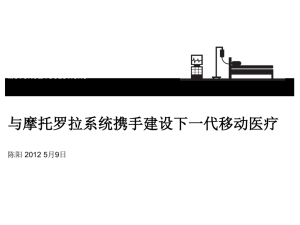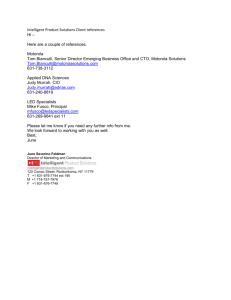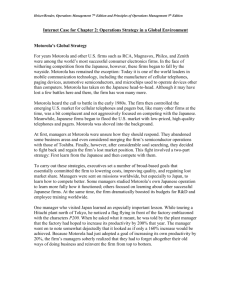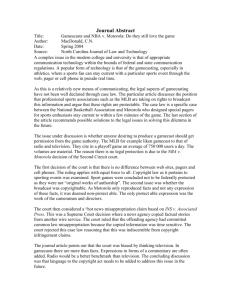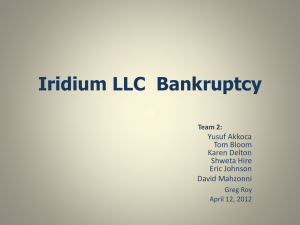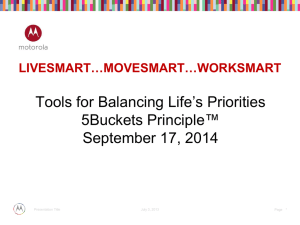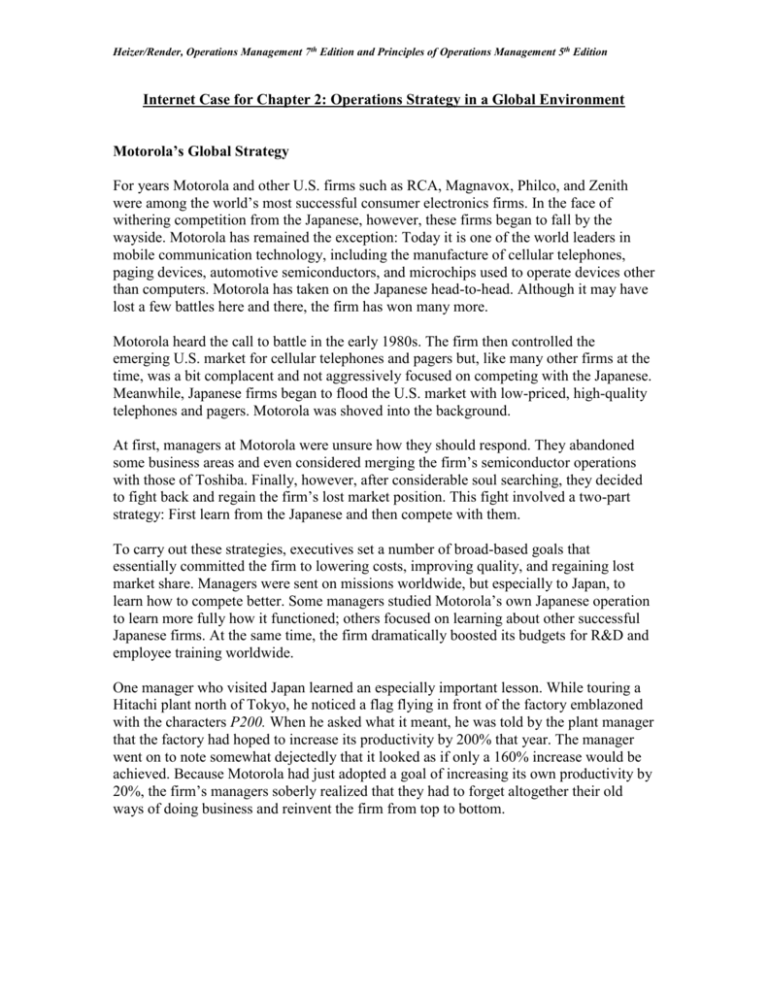
Heizer/Render, Operations Management 7th Edition and Principles of Operations Management 5th Edition
Internet Case for Chapter 2: Operations Strategy in a Global Environment
Motorola’s Global Strategy
For years Motorola and other U.S. firms such as RCA, Magnavox, Philco, and Zenith
were among the world’s most successful consumer electronics firms. In the face of
withering competition from the Japanese, however, these firms began to fall by the
wayside. Motorola has remained the exception: Today it is one of the world leaders in
mobile communication technology, including the manufacture of cellular telephones,
paging devices, automotive semiconductors, and microchips used to operate devices other
than computers. Motorola has taken on the Japanese head-to-head. Although it may have
lost a few battles here and there, the firm has won many more.
Motorola heard the call to battle in the early 1980s. The firm then controlled the
emerging U.S. market for cellular telephones and pagers but, like many other firms at the
time, was a bit complacent and not aggressively focused on competing with the Japanese.
Meanwhile, Japanese firms began to flood the U.S. market with low-priced, high-quality
telephones and pagers. Motorola was shoved into the background.
At first, managers at Motorola were unsure how they should respond. They abandoned
some business areas and even considered merging the firm’s semiconductor operations
with those of Toshiba. Finally, however, after considerable soul searching, they decided
to fight back and regain the firm’s lost market position. This fight involved a two-part
strategy: First learn from the Japanese and then compete with them.
To carry out these strategies, executives set a number of broad-based goals that
essentially committed the firm to lowering costs, improving quality, and regaining lost
market share. Managers were sent on missions worldwide, but especially to Japan, to
learn how to compete better. Some managers studied Motorola’s own Japanese operation
to learn more fully how it functioned; others focused on learning about other successful
Japanese firms. At the same time, the firm dramatically boosted its budgets for R&D and
employee training worldwide.
One manager who visited Japan learned an especially important lesson. While touring a
Hitachi plant north of Tokyo, he noticed a flag flying in front of the factory emblazoned
with the characters P200. When he asked what it meant, he was told by the plant manager
that the factory had hoped to increase its productivity by 200% that year. The manager
went on to note somewhat dejectedly that it looked as if only a 160% increase would be
achieved. Because Motorola had just adopted a goal of increasing its own productivity by
20%, the firm’s managers soberly realized that they had to forget altogether their old
ways of doing business and reinvent the firm from top to bottom.
Heizer/Render, Operations Management 7th Edition and Principles of Operations Management 5th Edition
Old plants were shuttered as new ones were built. Workers received new training in a
wide range of quality-enhancement techniques. The firm placed its new commitment to
quality at the forefront of everything it did. It even went so far as to announce publicly
what seemed at the time to be an impossible goal: to achieve Six Sigma quality, a
perfection rate of 99.9997%. When Motorola actually achieved this level of quality, it
received the prestigious Malcolm Baldrige National Quality Award.
Even more amazing have been Motorola’s successes abroad, especially in Japan. The
firm has 20 offices and more than 3,000 employees there. It is currently number three in
market share there in both pagers and cellular telephones. Worldwide, Motorola controls
much of the total market for these products, has regained its number-two position in
semiconductor sales, and is furiously launching so many new products that its rivals seem
baffled.
Today, Motorola generates over 56% of its revenues abroad. Major new initiatives are
underway in Asia, Latin America, and Eastern Europe. The firm has also made headway
in Western Europe against entrenched rivals Philips and Thomson. But not content to rest
on its laurels, Motorola has set new—and staggering—goals for itself. It wants to take
quality to the point where defects will be counted in relation to billions rather than
millions. It wants to cut its cycle times (the time required to produce a new product, the
time to fill an order, and/or the time necessary to change a production system from one
product to another) tenfold every five years. It also wants over 75% of its revenues to
come from foreign markets by 2002.
DISCUSSION QUESTIONS
1. What are the components of Motorola’s international strategy?
2. Describe how Motorola might have arrived at its current strategy as a result of a
SWOT analysis.
3. Discuss Motorola’s primary business strategy.
Source: adapted from R. W. Griffin and M. W. Pustay, International Business:
A Managerial Perspective, (pages 373/374) © 1999, 1996 Addison Wesley Longman. Reproduced by
permission of Addison Wesley Longman. All rights reserved.

